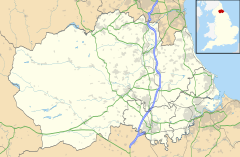Cockfield, County Durham facts for kids
Quick facts for kids Cockfield |
|
|---|---|
 St Mary the Virgin church, Cockfield |
|
| Population | 1,531 (2011) |
| OS grid reference | NZ126242 |
| Unitary authority |
|
| Ceremonial county | |
| Region | |
| Country | England |
| Sovereign state | United Kingdom |
| Post town | Bishop Auckland |
| Postcode district | DL13 |
| Dialling code | 01388 |
| Police | Durham |
| Fire | County Durham and Darlington |
| Ambulance | North East |
| EU Parliament | North East England |
| UK Parliament |
|
Cockfield is a village in County Durham, England. It is located in the beautiful area of Teesdale. The village is about 8 miles (13 km) southwest of Bishop Auckland. It is also 15 miles (24 km) northwest of Darlington.
People have lived in the Cockfield area for a very long time. Remains found on Cockfield Fell show that there was a settlement here during the Iron Age. This was thousands of years ago! The local church, called St Mary the Virgin, was likely built in the late 1100s.
Coal mining started in this area many centuries ago. In the 1800s and 1900s, more coal mines opened. This made the village grow a lot. However, the last coal mine in Cockfield closed in 1962.
Contents
Famous People from Cockfield
Some interesting people have come from Cockfield. The Martindale family was one of the most well-known.
- George Dixon (1731–1785)
George Dixon owned coal mines in the area. He was also a clever inventor. He was probably the first person to use coal gas to light up buildings. George Dixon passed away in Cockfield when he was 53.
- Jeremiah Dixon (1733–1779)
Jeremiah Dixon was George's brother. He was an astronomer, someone who studies stars and planets. In 1763, he traveled to America with Charles Mason. They worked together to map the borders of Maryland and Pennsylvania. This famous border is now known as the 'Mason–Dixon line'. Jeremiah Dixon died in Cockfield at the age of 45.
- John White (1826–1891)
John White was a famous expert on the Māori people of New Zealand. He wrote a book called "The Ancient History of the Maori". He also helped translate the Māori language for Governor Grey. This was during the New Zealand Land Wars. John White also wrote other stories about Māori culture.
Around the Village
Shops and Services
Cockfield has a few useful places to visit. There are three shops in the village. These include a Co-operative store, a newsagent, and a general store. The general store also has a coffee shop inside. You can also find a Pharmacy in the village. This pharmacy also has the Post Office.
Places to Eat and Meet
The village has three public houses, which are like local pubs. These are called the Queen's Head, the King's Head, and the Cockfield Working Men's Club.
Schools and Churches
The local primary school for children is Cockfield County Primary School. For churches, you can find two in Cockfield. There is the Church of England's Saint Mary the Virgin Church. There is also the Cockfield Methodist Church.
Getting Around
Cockfield used to have a railway line. However, it stopped carrying passengers in 1958. The railway closed completely in 1962. Today, you can travel by bus. Bus services link Cockfield to nearby towns. These include Darlington, Bishop Auckland, and Barnard Castle. You can also get to Durham and the Tindale Crescent retail park.
Cockfield Fell's History
Cockfield Fell is a very special place. It is called "one of the most important early industrial landscapes in Britain." This means it shows a lot about how people lived and worked long ago.
On the fell, you can find signs of four Iron Age settlements. These were villages from a very old time. There is also proof of early coal mines. People were mining coal here as early as 1303! You can also see old farm fields from the Middle Ages.
Over hundreds of years, people also quarried stone here. A railway line was built in the 1830s. There were also older tramways for moving goods. All these things together make Cockfield Fell England's largest Scheduled Ancient Monument. This means it is a protected historical site. It is special because it was not divided up into private land in the 1700s or 1800s. This helped to keep its amazing history safe.


